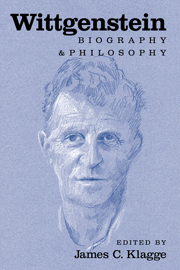Editor's Preface
Published online by Cambridge University Press: 27 March 2010
Summary
Introduction
No one who reads, or tries to read, the Tractatus can help wondering what kind of person its author was. Upon reading the Tractatus but before meeting its author, Theodore Redpath, a student of Ludwig Wittgenstein's from the mid- to late 1930s, imagined Wittgenstein “with the facial appearance of a ‘prophet,’ with a thin long sensitive, El Grecoish kind of face, framed by long strands of silvery hair and set with large, dark, expressive eyes.” The contrast created by reading the Philosophical Investigations can only increase one's curiosity.
Until Wittgenstein's death in 1951, knowledge of him as a person was limited to friends and students and rumor. For the next three dozen years it was refracted by a growing stream of memoirs and recollections by friends, students, and acquaintances. Finally, near the centenary anniversary of his birth, we began to know Wittgenstein through two well-researched biographies. The more we know of him as a person, the more interesting become the connections, and disconnections, to his philosophical work. With these biographies, the real work has now begun of understanding Wittgenstein as a person and a thinker. This collection of papers continues that work. What stands out in many of these papers is the attention to recently published material – Wittgenstein's diaries from the 1930s, his correspondence with his family, his engineering training.
The bulk of the papers that follow were delivered at the Virginia Tech Philosophy Department's annual spring conference, held 25–28 March 1999, on the topic “Wittgenstein: Biography and Philosophy.”
- Type
- Chapter
- Information
- WittgensteinBiography and Philosophy, pp. ix - xvPublisher: Cambridge University PressPrint publication year: 2001



